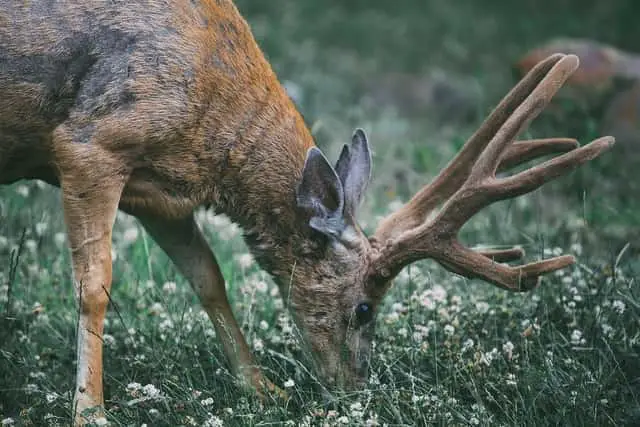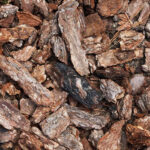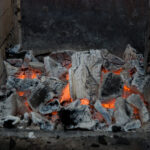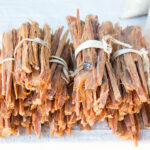After a successful hunt, many deer hunters begin to worry about their deer antlers shrinking after they have completely dried.
But just how much do antlers shrink, and should you be worried about it?
Let’s take a deeper dive into antler shrinkage, how you might be able to avoid it, and how much shrinkage you can expect after drying!
Table of Contents
- How Much Do Deer Antlers Shrink After Drying?
- How Much Do Elk Antlers Shrink?
- How Much Antler Shrinkage Should I Expect?
- How To Keep Deer Antlers From Shrinking
- Do Deer Antlers Shrink in the Freezer?
- Why Do Deer Antlers Shrink?
- Frequently Asked Questions
- Final Thoughts
How Much Do Deer Antlers Shrink After Drying?
In most cases, hunters will not notice any visible antler shrinkage after the drying period. However, on exceptionally large racks of 160 inches or more, antlers may shrink up to 2 inches in overall score, or up to 4″ if the antlers are in velvet.

How Much Do Elk Antlers Shrink?
Elk antlers are capable of shrinkage, and the amount depends on if they are in velvet or completely hard antlers. Velvet Elk antlers have shrunk as much as 4 inches during the 60 day drying period required by Boone and Crockett.
How Much Antler Shrinkage Should I Expect?
Luckily you do not have to worry much about any large amounts of antler shrinkage with any deer antlers you have. While shrinkage does occur after the deer’s death, even large whitetail bucks will not shrink more than one or two inches from the time they are killed to when the antlers are completely dried out.
Of course, every rack is different. The bigger the antlers, the more prone they are to shrinkage as well.
There are a few documented cases of giant 200-inch deer that have lost up to four or five inches from shrinkage.
This is why many record-keeping organizations, such as Boone and Crockett, will have a 60-day drying period before taking official measurements in order to account for any shrinkage.
You can learn more about their policy on antler shrinkage and drying periods at https://www.boone-crockett.org/do-antlers-and-horns-really-shrink.
For the average buck, you will most likely not even notice any shrinkage at all.
Thanks to the low amount of moisture and tissue leftover in a deer antler after it has hardened and calcified, shrinkage is generally very minimal and hardly noticeable.
The only time it really starts to become a big deal is in the record books for those that care.
How To Keep Deer Antlers From Shrinking
While antlers will shrink a little as they age, there are a few simple things that you can do in order to minimize this effect.
First, do not cut the antlers off of the skull and leave them attached. Many hunters will cut the skull cap off in order to mount an animal, but a skull cap will shrink as well. In order to keep the antlers as best as you can, leave the entire skull intact before scoring the antlers.
Along with keeping the skull in place, avoid boiling it out as well.
As you might expect, the heat and moisture that boiling puts into a skull will cause the bones to swell and then shrink.
Instead, search for someone in your area with dermestid beetles that will eat the flesh off of the bone.
This method is especially popular with ‘dead heads’ or roadkill deer when hunters want to preserve antlers and skulls.
Not only is this process less messy and smelly than boiling, but it will avoid any shrinkage problems that boiling can produce.
You May Also Like: How Much Are Shed Antlers Worth & How Do You Sell Them?
Do Deer Antlers Shrink in the Freezer?
Placing deer antlers in the freezer can cause some slight shrinkage in certain situations. While heat causes things to expand, the cold will cause them to constrict and shrink. This is especially true if the antlers are still attached to a fresh skull that has not been properly cleaned yet.
As you take the antlers out of the freezer and they warm up, they should return to the normal size.
But again, the actual shrinkage that a freezer will cause is hardly even noticeable.
Antlers that are left in a freezer for longer periods of time will also slowly dry out, going through the regular shrinking and drying process that they would otherwise.
Why Do Deer Antlers Shrink?
While antler shrinkage while drying is not uncommon, it rarely will make a huge difference when it comes to a deer’s score.
The actual antler shrinkage will occur as a result of the chemical makeup of the antlers. The rack on a deer or elk begins as living tissue that is full of blood and organic material that will eventually start to calcify as the deer sheds the velvet and the antlers harden.
Although at this point it is hardened and calcified, it is still living tissue when it is attached to the skull and is very porous.
Once the deer is actually dead (or the antler is dropped as a shed), the antler will begin to completely dry die and dry out. As it does this, it will lose any leftover moisture inside the bone and slightly shrink in size.
Frequently Asked Questions
Does antler shrinkage affect a deer’s score?
Yes, even slight shrinkage can affect an official score. This is why organizations such as Boone-and-Crockett utilize a 60-day drying period to allow for shrinkage to occur first.
Is there any way to avoid deer antler shrinkage?
While there are a few ways to help minimize shrinkage, there is no way to completely avoid it.
Do antlers from other species shrink after death as well?
Yes, every horn or antler from any species will shrink a little after death as they completely dry out and lose moisture.
Do velvet antlers shrink as well?
Antlers that are still in velvet will tend to shrink a little more than regular, hard-horned antlers. This is due to the fact that they have much more blood, tissue, and moisture inside of them that will cause the antler to shrink down as it is taken out.
Final Thoughts
While antler shrinkage is a real thing, it is not something that most hunters should be concerned with.
Antler shrinkage is a natural process that will happen no matter what you do, but the effects are very minimal in 99% of the cases out there.
In fact, most people will never even be able to tell that their antlers have shrunk even after long periods of time!
You May Also Like: Why Do Deer Antlers Sometimes Smell?





